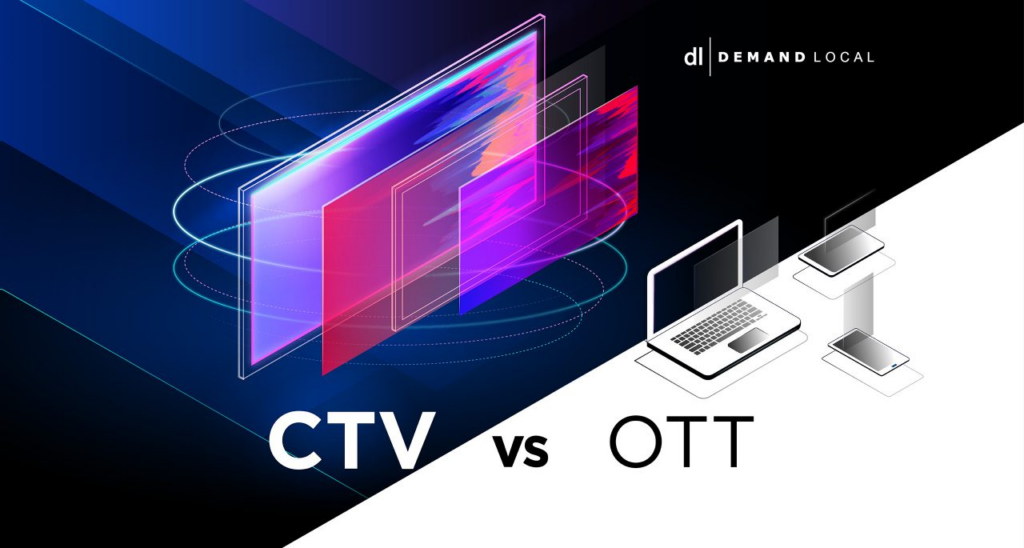The video industry is shifting between two major distribution models – OTT and CTV. While they sound very similar to streaming platforms, OTT and CTV utilize different technical approaches.
For consumers navigating the myriad viewing options, understanding the core differences between OTT and CTV is crucial. This comprehensive guide examines how OTT and CTV services diverge.

Defining OTT and CTV
OTT
OTT stands for “over-the-top” and refers to film/TV content delivered directly over the open internet to connected devices. OTT bypasses cable, broadcast, and satellite networks.
Some major examples of OTT services:
- On-demand video services like Netflix, Prime Video, Hulu, Disney+
- Live TV streaming services like YouTube TV, Sling TV
- Free ad-supported video sites like YouTube and Facebook Watch
- Transactional VOD stores like Apple’s iTunes and Google Play Movies
OTT platforms can be accessed on any internet-connected device – smartphones, smart TVs, streaming boxes, game consoles, and more.
CTV
CTV stands for “connected TV” and represents the convergence of television content with internet-connected platforms. This includes:
- Smart TVs from brands like Samsung, LG, and Sony with built-in internet streaming capabilities.
- Media streaming devices like Roku, Fire TV, and Apple TV that connect existing TVs.
- Gaming consoles like Xbox and PlayStation that double as media hubs.
These CTV devices utilize OTT-based video delivery over the open internet to power their apps and streaming services.
So in summary:
- OTT refers to the technical video delivery method over the Internet.
- CTV represents the internet-connected devices delivering OTT video into the living room.
OTT vs. CTV – Key Differences
While CTV depends on OTT content delivery, there are some core differences between the two concepts:
Delivery System
- OTT is the actual delivery mechanism – video content streamed over the open internet and delivered directly to users.
- CTV represents the endpoint hardware receiving OTT video – the smart TVs, media players, game consoles, etc. that bring internet content to the big screen.
Scope
- OTT has a broader scope that also encompasses mobile and desktop video streaming over the internet.
- CTV focuses more narrowly on the living room smart TV experience consuming OTT content.
User Experience
- OTT offers a wide range of user experiences tailored to different devices – mobile, desktop, and living room.
- The CTV experience centers specifically on accessing and interacting with OTT video on television via connected platforms.
Business Model
- OTT can refer to multiple different streaming business models – subscription, advertising, transactions, etc.
- CTV primarily refers to ad-supported and subscriber-based business models for video services available through connected TV platforms.
Technology Needs
- OTT video can work on any device with an internet connection and streaming app – no specialized device is needed.
- CTV requires owning a smart TV, streaming stick, or games console to display OTT content on your TV. The technology goes beyond pure internet video.
So in summary, OTT provides the delivery railroad while CTV represents the consumer-facing engine bringing streaming content to modern television sets – they work together to enable the living room streaming experience.

The Rise of CTV Platforms
The core driving force behind CTV’s growing popularity is the proliferation of smart TVs and streaming devices that provide easy access to OTT content in the living room environment.
Key developments fueling CTV adoption include:
- Rapid growth in global smart TV penetration, which is expected to reach over 50% of households in 2022. Samsung, LG, Sony, and other brands now sell more smart TVs than traditional sets.
- Affordable streaming devices like Roku and Fire TV stick making it easy to add smart capabilities to existing televisions for under $50 in many cases. Global media device shipments hit 121 million units in 2021.
- The shift to 4K displays provides greater resolution and high dynamic range video quality to enhance the streaming experience.
- User-friendly smart TV interfaces like webOS, Tizen, and Google TV seamlessly aggregate and recommend streaming content from various OTT apps.
- Launch of cloud gaming services like Xbox Cloud Gaming accessible through CTV devices.
- Targeted advertising opportunities based on data from CTV viewing enabling more personalized and measurable video ad campaigns.
With the proliferation of high-quality CTV hardware and software, OTT platforms are increasingly prioritizing the optimization of their apps and services for large-screen living room viewing.
For consumers, CTV offers the most seamless and rich streaming experience available. The CTV ecosystem provides the crucial missing link bridging internet video to the preferred environment of television for billions of people globally.
Pros and Cons of OTT vs. CTV for Viewers
Both OTT and CTV platforms provide distinct sets of advantages and drawbacks from a consumer perspective.
OTT Pros
- Accessible across all types of internet-connected devices
- On-demand viewing experience
- Ability to subscribe directly to streaming services
- Lower subscription costs than cable
- Free ad-supported tiers on many services
OTT Cons
- Small screens on mobile devices
- Need consistent high-speed internet
- Fragmented subscriptions across apps
- Limited options for live content
CTV Pros
- Large-screen television viewing experience
- Aggregates many streaming apps
- Intuitive smart TV interfaces
- Ad-supported free content
- Ability to cast video to TVs from mobile apps
CTV Cons
- Requires purchasing a new TV or streaming device
- Dependence on smart platforms limits viewing (Roku vs Fire TV etc)
- Complexity navigating many apps and services
- Limited portability compared to mobile streaming
For most mainstream consumers today, the ideal solution is an integrated OTT + CTV experience:
- OTT for on-the-go mobile streaming and app flexibility
- CTV for the premium living room viewing environment accessing the same OTT apps in a television-optimized format
Heavy streamers might prefer app-based OTT-only setups they can customize, while more casual viewers benefit from CTV’s simplicity and living room integration.
But overall, OTT and CTV are complementary rather than competitive – they work together to meet the diverse needs of modern multimedia consumers.
Leading Players in OTT and CTV
While the technologies differ, many of the same major providers operate across the OTT and CTV spectrums:
Top OTT Platforms
- Video on Demand: Netflix, Prime Video, Hulu, Disney+, Apple TV+, Discovery+
- Live TV Streaming: YouTube TV, Hulu Live, Sling TV, FuboTV
- Transactional VOD: iTunes, Google Play Movies, Amazon Video, Vudu
- Ad-Supported: YouTube, Facebook Watch, Tubi, Pluto TV
Top CTV Platforms
- Smart TV OEMs: Samsung, LG, Sony, VIZIO, TCL, Hisense
- Streaming Devices: Roku, Amazon Fire TV, Apple TV, Chromecast
- Gaming Consoles: PlayStation, Xbox, Nintendo Switch
- Smart Device Makers: Apple (iPhone/iPad), Google (Android), Amazon (Fire tablets)
Major media and tech companies like Amazon, Apple, Google, Roku, and Samsung maintain strong positions across both spheres. Being able to deliver streaming OTT video along with the CTV software and hardware to access it is crucial to dominate the ecosystem.
While disruptors will emerge, the foremost OTT and CTV players solidifying their convergent empires are situated to thrive as living room streaming expands worldwide.
OTT vs. CTV – What Does the Future Hold?
In the years ahead, OTT video delivered over CTV platforms will continue displacing traditional television:
- More 4K/8K UHD – Ultra high-definition video will become standard across all major OTT/CTV services. Resolution and HDR quality will approach physical media.
- Expanded live content – Major CTV platforms may partner with cable networks and sports leagues to integrate more digital-first live channels and broadcasts.
- Growth of AVOD – Ad-supported VOD networks will proliferate on CTV, following the success of services like Pluto TV, Tubi, and the Roku Channel. AVOD will disrupt subscription fatigue.
- Voice control – CTV voice assistants will evolve to enable seamless content discovery and management across services. Voice optimization will be imperative for OTT providers.
- Targeted advertising – Data-driven CTV advertising will surpass linear TV, using cross-app data to serve highly personalized video ads targeted to viewer interests.
- Global expansion – CTV and OTT will continue growing rapidly in developing digital markets like India, bringing internet video to billions of new consumers.
- Cloud gaming integration – CTV platforms will converge with game streaming services to create hybrid entertainment hubs centered around the television.
Cutting the cord will accelerate as quality, breadth of content, and ease of use for OTT/CTV ecosystems improves. While linear television persists, its prominence will fade as internet-delivered video becomes the standard.

Frequently Asked Questions (FAQ)
Q1. Can you get OTT apps on smart TVs?
Ans. Yes, modern smart TVs from brands like Samsung, LG, Sony, and VIZIO all come pre-loaded with many major OTT apps like Netflix, Prime Video, Disney+, Hulu, YouTube, and more. Smart TVs provide the most seamless way to access OTT content through CTVs.
Q2. What’s the difference between Roku and Fire TV?
Ans. Roku and Fire TV are the most popular dedicated media streaming device platforms in the CTV market. The main difference is Roku delivers a more pure content-neutral streaming experience while Fire TV promotes Amazon content. Both support all major OTT apps.
Q3. Is Roku an OTT or CTV service?
Ans. Roku is primarily a CTV platform – its core business is making streaming devices and smart TV software to access OTT content. However, Roku has branched into providing some of its own OTT video channels and content to compete with Amazon.
Q4. Can I watch OTT videos on game consoles?
Ans. Yes, modern game consoles like the PlayStation 5, Xbox Series X, and Nintendo Switch all support apps for the major OTT video services like Netflix and Hulu. Many consumers use consoles as multimedia hubs in their living room setup.
Q5. Which is better – OTT or CTV?
Ans. OTT provides the streaming video delivery system while CTV represents the platforms consuming OTT content. Most consumers are best served by using both – OTT for mobile viewing and CTV for accessing the same OTT video services on the big-screen TV. OTT and CTV complement each other.




